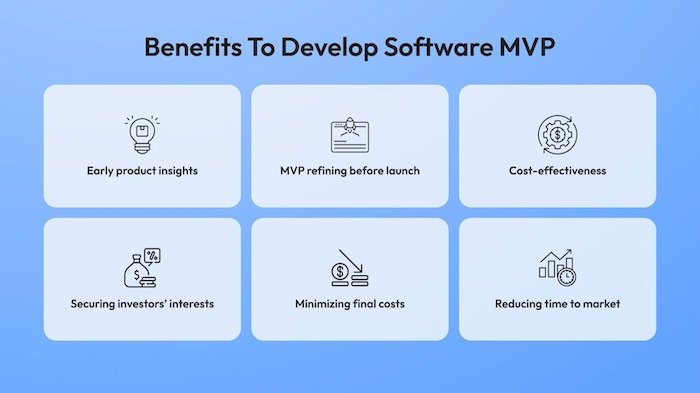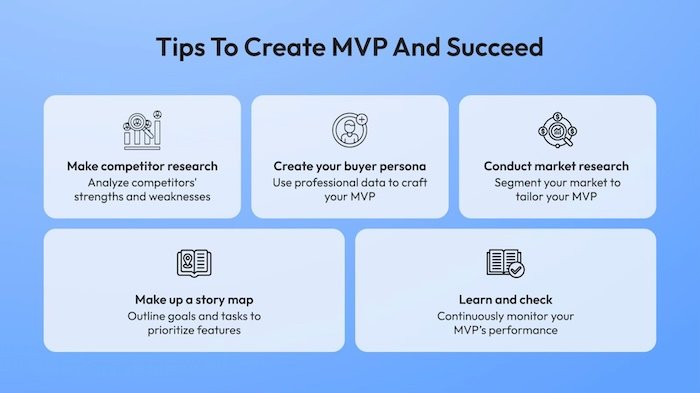Creating a new idea for a product and releasing it in 2025 requires strategy, and for this, there’s a Minimum Viable Product (MVP). An MVP allows you to test your idea, acquire early users, and learn from them without wasting massive amounts of money and time.
In this book, we’re going to take you step-by-step through developing a successful MVP, from problem defining to launch and iteration with real feedback. Whether you’re a startup founder or a product leader, this process can be your secret to idea validation and setting up for future growth.
What’s An MVP and How Does It Work?
A Minimum Viable Product (MVP) is the minimum of your product with value. It’s not releasing something perfect, but testing concepts rapidly, gaining real feedback, and iterating. Think of it as a minimal prototype with enough features for early adoption and proving demand.

Some of the biggest startups had their origins with an MVP. Instagram started with a check-in app called Burbn, but user behavior forced them into prioritizing photos. Airbnb went live with a simple web page renting a single flat. Airbnb’s earliest users shaped what these apps evolved into.
Step 1: Identify the problem to be solved
Before anything, find the problem being solved. If your product doesn’t address a real problem, then it’s not going to take flight. The purpose of this step is understanding your target audience and if your idea has real demand.
How to pinpoint the right problem
Conduct market research and find out what your audience’s pain points are.
Research your competition and discover gaps in the market.
Survey and interview your target audience.
Slack, for instance, sprouted up to address fragmented team chat. Before writing code, they defined their primary challenge: simplifying workplace chat. State your problem as briefly and elegantly as they did.
Also Read: Financial Investment in Building a SaaS Platform
Step 2: Set your core features
Once you’ve defined the problem, the second step is defining your key features. Your MVP needs to perform a single thing exceptionally. Secondary features can be thought of after.
Prioritize your features
Prioritize your must-haves, not your nice-to-haves.
Set up a concise user journey for intuitive use.
Set up a feature road map for future growth.
An MVP needs to be lean. No extraneous fluff. If your app generates a meal-planning app, meal plans and shopping lists are must-haves. Social sharing? Nice, not necessary.
A useful rule of thumb: If a feature doesn’t enable achieving the primary goal, it can be thought of after. Build lean, then scale.
Step 3: Choose the right technology
The technology choice matters. Your stack of technologies needs to accommodate your MVP’s needs and leave space for growth. Solutions for enterprises don’t need solving immediately — just what’s necessary for launch. This is important especially if you are building a SaaS platform because that means scalability, multi-tenancy, and capability of integrating every step of the way.
Things to consider
Speed: Does your stack of technologies allow for a speedy development cycle?
Scalability: Does it allow for future growth?
Cost: Does it fit your finances for an early-stage product?
Your stack of technologies needs to be commensurate with your goals. With a web-based MVP, frameworks such as React (for the front-end) and Node.js (for the back-end) are a solid choice. No-code platforms like Bubble are also an option if speed matters more than custom development.
Dropbox launched with a straightforward video demo and then built its backend. Test other solutions before shelling out for costly development.
Also Read: Building an Enterprise App: 5 Strategies for Success
Step 4: Build and launch quickly
Speed matters when working on MVP. The more delay, the more feedback you may miss. The goal with this approach is to present something useful in front of real people quickly.
Tactics for a quick launch
Adopt agile approaches of developing.
Leverage no- and low-code solutions where possible.
Focus on a single use case and excel with it.
A technique is the “Wizard of Oz” MVP — in which everything looks automatic, but real people complete the task in the background. Zappos did this, testing demand without automating.
Step 5: Iterate and gain feedback
An MVP’s value depends on the feedback it generates. Listen to your earliest consumers and use their feedback to inform your product. This iteration and feedback collection process is where the real value of your MVP exists.
Techniques for gaining feedback
Run user testing sessions.
Observe what people are doing with Hotjar, for example, or with Google Analytics.
Listen on social and on support channels for qualitative feedback.
Amazon’s earliest consumers needed books. Its MVP addressed book buying online. But customer feedback led them to grow into today’s e-commerce giant.
Common Pitfalls to Avoid
During MVP development, many entrepreneurs fall into familiar traps that can sidetrack them. Avoid them and save your valuable time, money, and effort, and your product development stays on the straight and narrow.
Mistakes to be avoided:
- Overbuilding: The greatest mistake is incorporating too many features too rapidly. An MVP has to be lean and focused, allowing for testing of critical functionality. The addition of superfluous features not only delays launch, but also adds complexity and cost. Prioritize the bare minimum and scale from there, adapting to feedback from your audience.
- Ignoring your audience: Your earliest adopters are your greatest assets. If they don’t find value in your MVP, it’s critical to listen and learn. Ignoring feedback from your audience, dismissing their feedback, and claiming knowledge of what’s best without corroboration can lead to a product with zero traction. Speak with your audience, learn, and iterate.
- Omitting validation: Launching an MVP without studying your target audience and industry can be blind. If you don’t validate your idea with surveys, competitor research, and pilot testing, there’s a possibility of developing something people don’t need. Always be certain there’s demand for your solution before investing significant money and effort into developing.
- Prioritizing perfection: Many founders take too long launching because they want everything perfect. An MVP, however, is meant to be a starting point, not a destination. Prioritize learning, not perfection — launch quickly, learn from feedback, and scale from real-world usage.
- Neglecting scalability: An MVP has to be lean, but not lean enough to stifle future growth. Poor architectural design and short-term technical solutions without foresight for growth can stifle growth when your user count expands. Prioritize simplicity with a solid infrastructure.
By being watchful of these common pitfalls, you can more effectively manage MVP development, reducing your risk and maximizing your chances of producing a successful product. To keep you on the right path, follow these tips to build a solid MVP and set it up for success:
Also Read: 10 Features of Resource Management Software
Last Thoughts
Making an MVP in 2025 means being fast, being precise, and testing in the real world. The best ideas sprout from user needs, not hypotheses. Build small, learn from feedback, and repeat. Your future unicorn can be made from a humble MVP.

